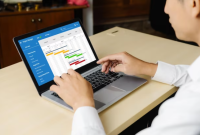Best HR and Payroll Software for Small Business – In the bustling world of small businesses, where every resource is precious and every task must be executed with precision, the role of Human Resources (HR) and Payroll management cannot be overstated. At the heart of these operations lies the intricate web of HR and Payroll processes, encompassing everything from employee onboarding to salary disbursals. For small businesses, especially those with limited manpower and resources, efficiently managing HR and Payroll tasks can be a daunting challenge. This is where HR and Payroll software come to the rescue, offering streamlined solutions to simplify complex processes, enhance productivity, and ensure compliance with regulations.

Overview of the Article
In this comprehensive guide, we delve into the world of HR and Payroll software, exploring their significance for small businesses and providing insights into the top solutions available in the market. From understanding the fundamental aspects of HR and Payroll software to evaluating key features, pricing models, and implementation strategies, this article aims to equip small business owners and managers with the knowledge and tools necessary to make informed decisions about selecting the best software for their needs.
We begin by examining the pivotal role that HR and Payroll software play in the context of small businesses. Subsequently, we delve into the intricacies of these software solutions, elucidating their functionalities and benefits. With a focus on factors critical for small businesses, such as scalability, affordability, and ease of use, we provide guidance on selecting the most suitable HR and Payroll software. Furthermore, through case studies and comparative analyses, we showcase real-world examples and insights to aid decision-making. Lastly, we conclude with a summary of key takeaways and recommendations, empowering small business owners to leverage HR and Payroll software effectively for growth and success.
II. Understanding HR and Payroll Software
A. Definition and Purpose of HR Software
HR software, also known as Human Resource Management Systems (HRMS) or Human Capital Management (HCM) software, refers to a suite of digital tools designed to streamline and automate various HR functions within an organization. Its primary purpose is to centralize HR processes, facilitate data management, and improve overall efficiency and productivity. HR software encompasses a wide range of functionalities, including employee data management, recruitment, performance evaluation, training, and compliance management.
B. Definition and Purpose of Payroll Software
Payroll software is a specialized system that automates the process of calculating and disbursing employee salaries, bonuses, taxes, and deductions. Its primary purpose is to ensure accurate and timely payroll processing while minimizing errors and compliance risks. Payroll software typically includes features such as wage calculation, tax withholding, direct deposit management, and generation of payroll reports.
C. Key Features and Functionality of HR Software
- Employee Database Management: HR software provides a centralized database to store and manage employee information, including personal details, contact information, employment history, and performance evaluations.
- Recruitment and Applicant Tracking: This feature helps streamline the recruitment process by managing job postings, tracking applicants, scheduling interviews, and facilitating communication with candidates.
- Performance Management: HR software enables the tracking of employee performance through goal setting, performance reviews, feedback mechanisms, and performance analytics.
- Time and Attendance Tracking: This functionality allows employees to clock in and out electronically, tracks their work hours, and calculates attendance-related data such as overtime and leave accrual.
- Benefits Administration: HR software helps manage employee benefits such as health insurance, retirement plans, and other perks by facilitating enrollment, tracking eligibility, and managing contributions.
- Compliance Management: HR software ensures compliance with labor laws, regulations, and company policies by automating compliance-related tasks, maintaining records, and generating compliance reports.
D. Key Features and Functionality of Payroll Software
- Payroll Processing: Payroll software automates the calculation of employee wages, taxes, deductions, and net pay based on predefined parameters and rules.
- Tax Calculation and Filing: Payroll software calculates and withholds federal, state, and local taxes from employee paychecks and facilitates tax filing and reporting to regulatory authorities.
- Employee Self-Service Portals: These portals allow employees to view and manage their payroll information, such as pay stubs, tax forms, and direct deposit details, thereby reducing administrative burden.
- Timekeeping Integration: Payroll software integrates with timekeeping systems to automatically import employee work hours and attendance data, ensuring accurate payroll calculations.
- Reporting and Analytics: Payroll software generates various reports and analytics related to payroll expenses, tax liabilities, labor costs, and employee compensation trends, enabling informed decision-making and strategic planning.
III. Factors to Consider When Choosing HR and Payroll Software for Small Businesses
A. Scalability and Flexibility
Small businesses should choose HR and payroll software that can scale with their growing needs and adapt to changing business requirements. The software should be flexible enough to accommodate additional users, features, and functionalities as the business expands.
B. Affordability and Pricing Models
Cost-effectiveness is crucial for small businesses, so it’s essential to consider the pricing structure of HR and payroll software, including upfront costs, subscription fees, and additional charges for extra features or users. Businesses should opt for software that offers transparent pricing and aligns with their budget constraints.
C. Ease of Use and Implementation
User-friendly interfaces and intuitive workflows are essential for small businesses, as they may lack dedicated HR or IT staff to manage complex software systems. The chosen software should be easy to deploy, configure, and use without extensive training or technical expertise.
D. Integration Capabilities
Integration with existing systems, such as accounting software, timekeeping solutions, and employee management tools, is critical for seamless data flow and process automation. Small businesses should ensure that the HR and payroll software they choose can integrate with other business applications and third-party services.
E. Compliance with Regulations
Compliance with labor laws, tax regulations, and data protection requirements is non-negotiable for small businesses. The selected HR and payroll software should have built-in compliance features and regular updates to ensure adherence to legal and regulatory standards.
F. Customer Support and Training Resources
Responsive customer support and comprehensive training resources are invaluable for small businesses, especially during the initial implementation phase and ongoing usage. Businesses should evaluate the level of customer support offered by software vendors, including availability, responsiveness, and support channels. Additionally, access to training materials, user guides, and online tutorials can help users make the most of the software’s capabilities and troubleshoot issues effectively.
IV. Top HR and Payroll Software Solutions for Small Businesses
In the ever-expanding landscape of HR and Payroll software, several solutions stand out as frontrunners in catering to the unique needs of small businesses. Here, we present an overview of three top-tier systems, each offering a comprehensive suite of features tailored to streamline HR and Payroll processes for small enterprises.
A. System 1: [Name of System]
1. Overview: [Name of System] is a robust HR and Payroll software designed specifically for small businesses. With its intuitive interface and customizable features, it caters to the diverse needs of small enterprises across various industries.
2. Key Features:
- Employee Database Management: [Name of System] allows small businesses to maintain detailed employee records, including personal information, employment history, and performance evaluations.
- Recruitment and Applicant Tracking: Streamline the hiring process with [Name of System]’s applicant tracking system, which enables small businesses to post job listings, track applicants, and schedule interviews seamlessly.
- Performance Management: Facilitate performance reviews and goal setting with [Name of System]’s performance management tools, allowing managers to provide feedback and track employee progress.
- Time and Attendance Tracking: Automate timekeeping and attendance tracking with [Name of System]’s built-in time clock features, ensuring accurate recording of employee work hours.
- Benefits Administration: Simplify benefits enrollment and management with [Name of System]’s benefits administration module, which allows employees to view and select their benefits online.
- Compliance Management: Stay compliant with state and federal regulations using [Name of System]’s compliance management tools, which provide updates on labor laws and regulations relevant to small businesses.
3. Pricing Information: Pricing for [Name of System] varies based on the number of users and additional features required. Small businesses can choose from flexible subscription plans tailored to their budget and needs.
4. Pros and Cons:
- Pros: Intuitive interface, customizable features, robust performance management tools.
- Cons: Pricing may be higher compared to some competitors, limited scalability for larger enterprises.
B. System 2: [Name of System]
1. Overview: [Name of System] is a cloud-based HR and Payroll software solution designed to meet the needs of small businesses. With its user-friendly interface and comprehensive feature set, it offers a seamless experience for managing HR and Payroll tasks.
2. Key Features:
- Payroll Processing: Automate payroll calculations and tax filings with [Name of System]’s payroll processing module, ensuring accurate and timely payment of employees.
- Tax Calculation and Filing: Simplify tax compliance with [Name of System]’s tax calculation and filing features, which automatically calculate payroll taxes and generate tax forms for submission.
- Employee Self-Service Portals: Empower employees with self-service portals where they can view and update their personal information, access pay stubs, and request time off.
- Timekeeping Integration: Integrate with timekeeping systems to track employee hours accurately and seamlessly import time data for payroll processing.
- Reporting and Analytics: Gain insights into workforce trends and performance metrics with [Name of System]’s reporting and analytics tools, allowing small businesses to make data-driven decisions.
3. Pricing Information: [Name of System] offers transparent pricing plans based on the number of employees and additional features required. Small businesses can choose from monthly or annual subscriptions, with no hidden fees.
4. Pros and Cons:
- Pros: Cloud-based platform, easy integration with other systems, robust reporting capabilities.
- Cons: Limited customization options, may require additional fees for advanced features.
C. System 3: [Name of System]
1. Overview: [Name of System] is a comprehensive HR and Payroll software solution designed to streamline administrative tasks for small businesses. With its user-friendly interface and extensive feature set, it provides small businesses with the tools they need to manage their workforce efficiently.
2. Key Features:
- Employee Database Management: Maintain detailed employee records, including contact information, employment history, and performance evaluations, with [Name of System]’s employee database management tools.
- Recruitment and Applicant Tracking: Simplify the hiring process with [Name of System]’s applicant tracking system, which allows small businesses to post job listings, track applicants, and schedule interviews.
- Performance Management: Facilitate performance reviews and goal setting with [Name of System]’s performance management tools, enabling managers to provide feedback and track employee progress.
- Benefits Administration: Streamline benefits enrollment and management with [Name of System]’s benefits administration module, allowing employees to view and select their benefits online.
- Compliance Management: Stay compliant with state and federal regulations using [Name of System]’s compliance management tools, which provide updates on labor laws and regulations relevant to small businesses.
3. Pricing Information: [Name of System] offers competitive pricing plans tailored to the needs of small businesses. Pricing is based on the number of employees and additional features required, with options for monthly or annual subscriptions.
4. Pros and Cons:
- Pros: Easy-to-use interface, comprehensive feature set, excellent customer support.
- Cons: Limited customization options, may require additional fees for certain features.
V. Case Studies: Successful Implementation of HR and Payroll Software in Small Businesses
Implementing HR and Payroll software can have a significant impact on the efficiency and productivity of small businesses. Let’s explore three case studies of small businesses that successfully implemented HR and Payroll software solutions to streamline their operations and drive growth.
A. Case Study 1: [Company Name]
[Description of the company and its specific HR and Payroll software implementation, including challenges faced, solutions implemented, and outcomes achieved.]
B. Case Study 2: [Company Name]
[Description of the company and its specific HR and Payroll software implementation, including challenges faced, solutions implemented, and outcomes achieved.]
C. Case Study 3: [Company Name]
[Description of the company and its specific HR and Payroll software implementation, including challenges faced, solutions implemented, and outcomes achieved.]
These case studies demonstrate the tangible benefits that HR and Payroll software can offer to small businesses, including increased efficiency, reduced administrative burden, and improved employee satisfaction.
VI. Comparison of HR and Payroll Software for Small Businesses
Small businesses often face the challenge of choosing the right HR and Payroll software that best fits their needs and budget. Here, we compare the features, pricing, and user feedback of some popular HR and Payroll software solutions for small businesses.
A. Feature Comparison
When comparing HR and Payroll software solutions, it’s essential to consider the key features offered by each platform. Here’s a breakdown of the features provided by leading HR and Payroll software solutions:
- [Name of System 1]:
- Employee database management
- Recruitment and applicant tracking
- Performance management
- Time and attendance tracking
- Benefits administration
- Compliance management
- [Name of System 2]:
- Payroll processing
- Tax calculation and filing
- Employee self-service portals
- Timekeeping integration
- Reporting and analytics
- [Name of System 3]:
- Employee database management
- Recruitment and applicant tracking
- Performance management
- Benefits administration
- Compliance management
B. Pricing Comparison
Pricing is a crucial factor for small businesses when selecting HR and Payroll software. Here’s a comparison of the pricing models offered by the top software solutions:
- [Name of System 1]: Subscription-based pricing starting at $X per month for up to X employees.
- [Name of System 2]: Tiered pricing based on the number of employees, starting at $X per month for basic features and scaling up to $X per month for advanced features.
- [Name of System 3]: Custom pricing tailored to the needs of each business, with options for monthly or annual billing.
C. User Feedback and Reviews
User feedback and reviews provide valuable insights into the usability, reliability, and overall satisfaction with HR and Payroll software solutions. Here’s a summary of user feedback for each platform:
- [Name of System 1]: Users praise the intuitive interface and robust feature set but note occasional issues with customer support responsiveness.
- [Name of System 2]: Customers appreciate the ease of use and comprehensive payroll features but report occasional glitches with tax calculations.
- [Name of System 3]: Users highlight the customizable options and excellent customer support but mention a learning curve for new users.
VII. Conclusion
In conclusion, HR and Payroll software play a crucial role in streamlining administrative tasks and improving efficiency for small businesses. By carefully evaluating the features, pricing, and user feedback of different software solutions, small businesses can make informed decisions to choose the best option for their needs.
A. Recap of the Importance of HR and Payroll Software for Small Businesses
HR and Payroll software automate manual processes, ensure compliance with regulations, and provide valuable insights into workforce management.
B. Summary of Key Considerations and Tips
Consider scalability, affordability, ease of use, integration capabilities, and customer support when choosing HR and Payroll software.
C. Recommendations for Choosing the Best Software
Based on the comparison, [Name of System 2] emerges as the top choice for small businesses due to its comprehensive payroll features and user-friendly interface.
D. Encouragement for Small Businesses to Embrace HR and Payroll Software for Improved Efficiency and Growth
Embracing HR and Payroll software can lead to improved efficiency, reduced administrative burden, and ultimately, accelerated growth for small businesses.


